TriaGnoSys, a leading provider of mobile satellite communications solutions, announced Thursday the successful trial of its disaster-recovery communications solution, designed to establish a GSM communications infrastructure in the first 24 hours following a disaster. One key usage is the electronic location tagging of injured victims and real-time transmission of their electronic medical records.
The unique advantage of the TriaGnoSys satellite-based solution is that it is sufficiently small to allow a single person to carry and deploy the equipment to establish a local GSM network. The network, which can be set up in minutes, has a range of 700 metres and anyone within that area using a GSM compatible electronic device – such as a GSM mobile phone, or a BlackBerry – can use it in exactly the same way as if they were in the middle of a city.
This new technology makes it possible for the first relief workers arriving at a disaster to set up a sophisticated communications network to co-ordinate both the relief effort and medical support. Victims can use it as well, although system priority is given to the relief effort. The GSM solution removes the need for expensive satellite phones, the current available solution, which can only be used by a single person or organisation.
Dr. Markus Werner, Managing Director of TriaGnoSys, said, "When disaster strikes, coordinating a response is often hampered by a lack of information and the lack of ability to communicate to emergency services, government and aid organisations. Without information about what is needed and where, support can easily be duplicated while others received no help at all. The TriaGnoSys solution means that people can use equipment they are familiar with, removing many current communication difficulties."
The TriaGnoSys solution was tested as part of the first demonstration of the disaster response communications systems developed by WISECOM, an EU-funded project, on May 28. The demonstration took place at the German Aerospace Centre (DLR) Institute of Communications and Navigation near Munich, Germany.
In these demonstrations, supported by the regional authorities for civil protection, fire brigades of the district of Starnberg and emergency physicians used and tested the equipment for the first time in a realistic disaster scenario.
One of the applications demonstrated was an electronic classification and registration of victims, or triage. GPS location and information of the victims were automatically transmitted from the rescue team’s PDAs via the satellite-based WISECOM communication infrastructure to a remote coordination centre. The patient’s records are transmitted electronically in real time to where they are needed, for example a field hospital or a near-by clinic. Because paper notes can be delayed, mislaid or damaged in disaster situations, electronically-transmitted triage information complements paper records by ensuring the patient’s records are in the right place at the right time.

